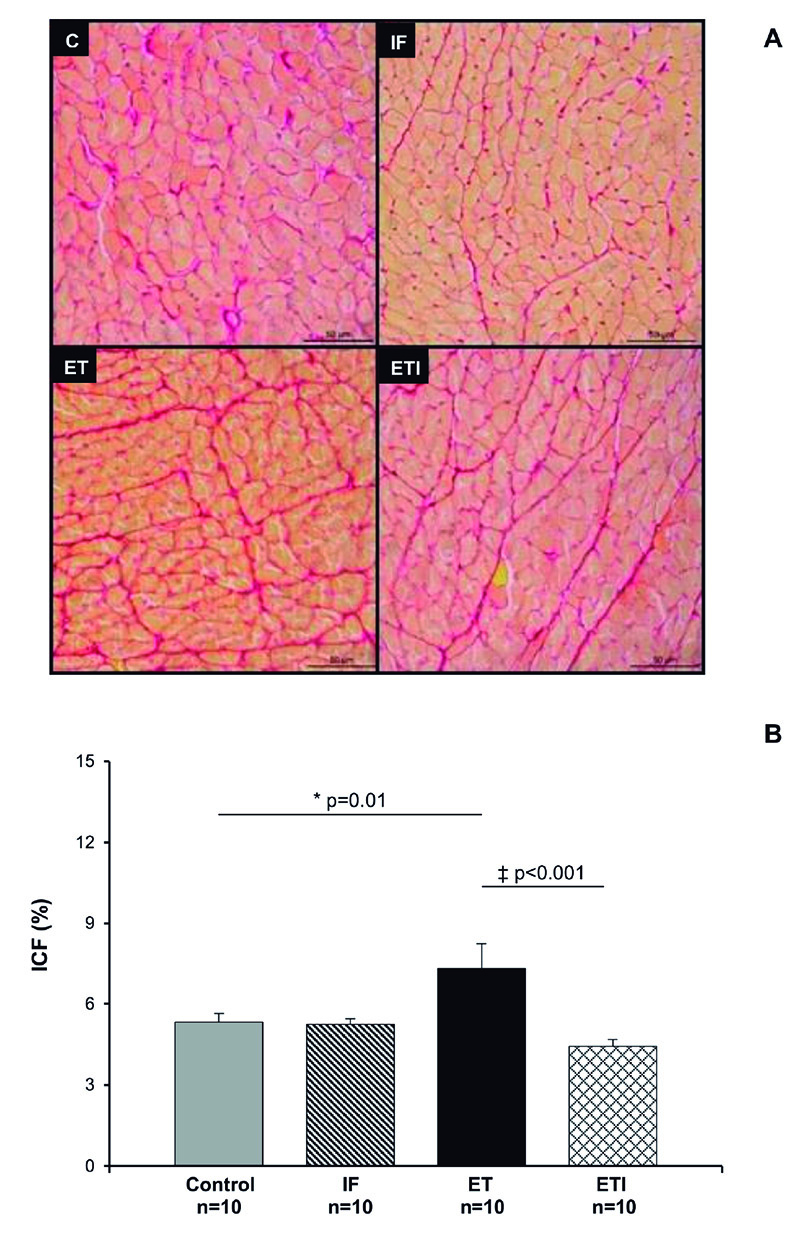Volume 115, Nº 2, August 2020
DOI: https://doi.org/10.36660/abc.20190349
ORIGINAL ARTICLE
Intermittent Fasting Attenuates Exercise Training-Induced Cardiac Remodeling
Priscilla Gois Basilio
Ana Priscila Cayres de Oliveira
Ana Carolini Ferreira de Castro
Marianna Rabelo de Carvalho
Alessandro Moura Zagatto
Paula Felippe Martinez
Marina Politi Okoshi
Katashi Okoshi
Gabriel Elias Ota
Filipe Abdalla dos Reis
Silvio Assis de Oliveira-Junior

Figure 4 – (A) Myocardial cross-sections stained with picrosirius red according to group. Control (C), sedentary rats receiving the control diet ad libitum; IF, sedentary rats undergoing intermittent fasting; ET: rats exercising and receiving the control diet ad libitum; ETI: rats exercising while intermittent fasting. (B) Interstitial collagen fraction (ICF); * p<0.05 vs. Control; ‡ p<0.05 vs. ET. Two-way ANOVA and Student-Newman-Keuls test.
Abstract
Background: The effects of non-pharmacological interventions such as calorie restriction and exercise training on health and prevention of cardiovascular diseases have been investigated in clinical and experimental studies.
Objective: To analyze the influence of intermittent fasting and exercise training on functional fitness, glycemia and cardiac remodeling.
Methods: Wistar rats (n=60) were randomly divided into four groups: control, exercise training (ET), intermittent fasting (IF) and exercise training plus intermittent fasting (ETI). Over 12 weeks, control and ET animals were fed daily a standard commercial diet ad libitum, while IF and ETI animals were fed every other day. In addition, the ET and ETI groups were submitted to a running protocol on a treadmill. After this period, functional fitness, nutritional parameters and blood glucose levels were analyzed. In addition to heart morphology, myocardial protein expression of extracellular signalregulated kinase (ERK) and c-Jun N-terminal kinase (JNK) was assessed by Western-blot. The results were analyzed using two-way ANOVA and Student-Newman-Keuls test. The level of significance considered was 5%.
Results: Exercise training increased functional fitness in the ET and ETI groups and promoted cardiac fibrosis. The combination of intermittent fasting and exercise training resulted in a smaller area under the blood glucose curve and reduced cardiomyocyte cross-sectional area and interstitial collagen fraction in the ETI group compared to ET. ERK and JNK expression levels were similar among groups (p>0.05).
Conclusions: Intermittent fasting is associated with improved glucose tolerance and attenuates cardiac remodeling induced by exercise training (Arq Bras Cardiol. 2020; 115(2):184-193)
Keywords: Diet; Calorie Restriction; Exercise; Running; Ventricular Remodeling; Glucose; Health Promotion.















